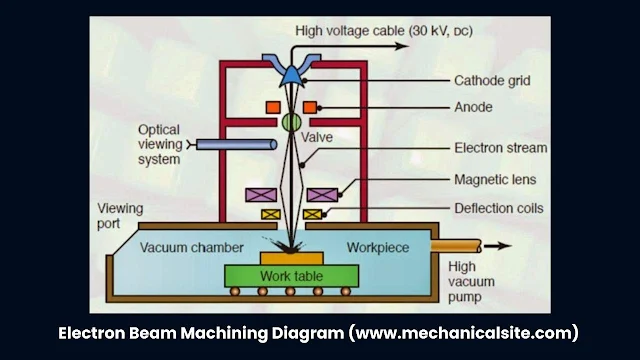Electron Beam Machining: Working Principle, Key Features & Applications
Electron Beam Machining: A Thermal Manufacturing Process
Electron beam machining (EBM) is a non-traditional thermal manufacturing process where high-velocity electrons are used to remove metal by melting and vaporizing. It is extremely precise and suitable for small, intricate cuts.
How EBM Works
- A focused beam of high-speed electrons is generated and directed toward the workpiece.
- The kinetic energy of electrons is converted into heat upon impact, melting, and vaporizing the metal.
- This erosion of metal occurs in a very localized spot, enabling intricate machining.
Key Features and Benefits of EBM
- Provides extremely narrow machining width, allowing micro-scale feature fabrication
- No physical contact between the tool and workpiece avoids mechanical stresses during machining
- Minimal heat-affected zone and small kerf width enable the machining of delicate items
- Easily machined holes have excellent diameter consistency due to the vaporization process
- High depth-to-diameter aspect ratio holes can be machined
Applications of Electron Beam Machining
- Drilling fine holes in turbine blades, nozzles, dies, and molds
- Making intricate cuts in micro-electro-mechanical systems (MEMS)
- Cutting tiny slots or holes in cardiovascular stents
- Machining parts made of refractive materials like quartz, ceramics, diamonds etc.
EBM vs Traditional Machining Processes
- EBM uses a concentrated beam of electrons rather than physical cutting tools
- No direct contact between the tool and workpiece in EBM avoids mechanical stresses
- EBM is highly suitable for micromachining while traditional methods have limitations
- Heat-affected zone in EBM is minimal compared to processes like laser beam machining
- Tight process control minimizes kerf width in EBM resulting in less material waste
Critical Process Parameters for EBM
- Accelerating voltage for electrons
- Electric current in electron beam
- Pulse duration
- Distance between workpiece and beam source
- Motion control of beam or workpiece
Optimizing these parameters is key to achieving desired machining accuracy, speed, and surface finish.
FAQ
What are the main components of an EBM system?
The main components are electron gun, electromagnetic lenses, deflection coils, machining chamber, vacuum system, numerical control system, and high voltage power supply.
What kind of surface finish can be attained using EBM?
It is possible to achieve surface roughness values ranging from 0.2 to 1.2 microns using EBM.
What materials can EBM process?
EBM can be used to machine any conductive material including metals, metallic alloys, doped semiconductors, and some non-metals like graphite.
What depth-to-diameter ratio holes are possible with EBM?
Holes with depth to diameter ratio of up to 300:1 can be easily achieved using EBM.
What are some safety concerns regarding EBM?
Some safety issues are exposure to x-rays and high energy electrons if proper shielding is not used around equipment. Proper safety protocols must be followed.







